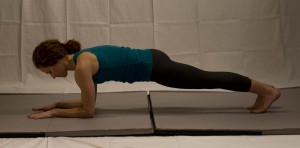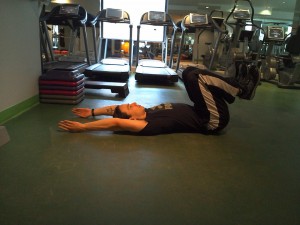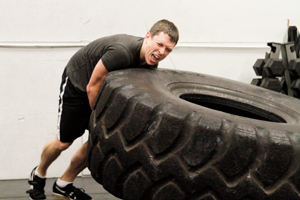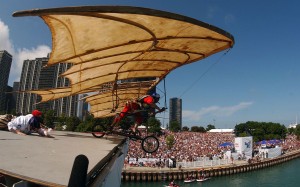Nothing says you have basic competency with your own body like a strict pull-up. Sadly, many men and women are suffering from severe pull-up deficiencies, unable to raise their heads over a bar even one time. Even worse, some have given up hope that they will ever get it up.
If this is you, fear no longer. I have helped many people get it up. And by “it” I mean their heads. Wait, wait. By “it” I mean…
You know what? Let’s just get to the details.
Likely reason(s) you can’t get it up, and exercise Viagra for your woes:
- Mobility deficit
- Motor control deficit (unloaded)
- Relative strength deficit
- Motor control deficit (loaded)
First, let’s clear one thing up: There is nothing natural about being able to do a pull-up. That’s why it’s so damn hard for most people. There is something very natural about being able to climb, and it’s a skill that is fading in the population, and we would do well to reintroduce climbing into our movement vocabularies, but I digress.
Pull-ups rock. They are your chance to declare that you are not normal. That you are abnormally capable with your own body. Remember: normal sucks.
If you are reading this, there is a good chance that you have already attempted to get good at pull-ups, but have had no luck. This is not your fault; there is a dearth of comprehensive pull-up info. Let’s change your luck. We’re going to assess where the weak link in your chain is so we can get you banging out pull-ups like our buddies Al & Danny Kavadlo:
Problem #1:
How’s the mobility?
Do me a favor. Sit on the floor with your back against a wall. Sit up tall. Keep your lowerback, upperback, and back of your head in contact with the wall. Lift both arms overhead in a thumbs up position, with the elbows straight, and touch your thumbs to the wall. Did you get there without changing your back, head, or elbow position? Did you get there without any pain or discomfort?
If the answer to either of those questions is “No,” you may have a mobility issue.
(If you had pain or discomfort, you’re beyond the scope of internet article help. Go meet, in person, with someone qualified to help you.)
If you failed the above test, lie on your back, with knees and hips flexed and re-test, again keeping the back and head against the ground with straight arms. If you suddenly, magically passed, you most likely have a motor control issue. We’ll get to you in a moment.
If you failed the test again, congrats, you have a mobility problem. Trying to do pull-ups right now would be like trying to drive with your handbrake on. You’re unlikely to do very well, and even if you do, something’s going to breakdown in the near future.
Focus on getting mobile enough to pass the above test and then come back to this article. Your thoracic spine extension, scapular upward rotation and posterior tilt, and shoulder flexion and external rotation are all involved in getting overhead. And remember the golden rules:
- Only mobilize that which is restricted.
- Use it or lose it. Once you improve mobility you need to convince the body you need that new range of motion or it’ll take it away. Hanging knee raises and overhead carries are good starting options here.
Improving mobility so you can get overhead could be (probably will be) a whole article unto itself.
If you have a mobility problem, don’t be an idiot. If you can’t get into the basic position unloaded, don’t try loading it until you can. Don’t be the kind of guy who can’t touch his toes but tries to flip tires and makes some orthopedist rich.
Problem #2:
Motor Control Deficit (Unloaded)
If you failed the last test while sitting but passed while lying down, or if you are someone who can’t control the position of your lower-back while holding onto the pull-up bar (i.e., you can’t stop the lumbar spine from extending) you get to start here.
You may or may not have a strength problem. Your body may just be unconvinced you can stabilize properly so it’s shutting down force production to stop you from injuring yourself. Yes, your body is this smart. Yes, this is happening without you knowing it. Yes, that’s why the following exercises don’t really look like pull-ups. Include the following at the end of your warm-up and watch awesomeness ensue:
Plank:

Push-ups:

Wheelbarrows:
If you don’t have gliders, you can use a towel under your feet
After performing the above you will go into your pull-up training. (Keep reading. More problem solving and training parameters are below.)
Problem #3:
Relative Strength Deficit
A relative strength deficit in the pull-up means that you weigh more than you can pull. There are two obvious solutions:
- Weigh less
- Be stronger
For those who are relatively lean, working on strength is the better bet. For those who are heftier, working on weighing less is a good plan. If you need to get stronger, you can use the below exercise to help improve your relative strength. If you need to lose weight, you can include the below exercises in your training to help you get to a lower bodyweight while you adjust your eating.
There are 4 popular ways of reducing the load to help you in your quest to get it up.
- Lat Pulldown
- Assisted Pull-Up Machines
- Band Assisted Pull-up
- Partner Assisted Pull-up
1 & 2) Lat Pulldown & Assisted Pull-Up Machines:
I’ll be honest here; I have never seen the lat pulldown or assisted pull-up machines result in a pull-up. For the majority of people, the movement patterns are not similar enough to transfer to pull-up strength, nor do they teach you to create appropriate tension through the body. (Could this be because core strength is position specific and because the body will reduce distal force production in the face of proximal instability? Nahhhhh.)
The next two both work, but each has advantages and disadvantages. The important thing is that you do one or the other…or both.
3) Band Assisted Pull-ups:
You get yourself a swanky Jumpstretch band, loop it around the bar, put your feet or shins on the band, and have it help you get up (I like feet on the band better, but this may not be an option depending on the height of your bar and if you need help lengthening the band). The biggest advantages to the band are that the movement pattern is highly transferrable to the pull-up and you can progressively use thinner bands to provide less assistance over time. The disadvantage is that there is less assistance at the top than at the bottom, which can lead to difficulty starting the pull-up as you progress through the bands. The good news is that the deficit at the start of the pull is relatively easy to overcome once you’ve moved past the band. The band is a great way to get the party started, but there’s still work to do afterwards.
4) Partner Assisted Pull-ups:
This is the old-school way. Have someone help you up. Make sure you get help from people you trust and are comfortable around. They will be very close to your nethers. The disadvantage to the partner assisted pull-up is that you’re relying on the skill of your partner to apply just enough force at just the right time. Also, you’ll need a partner. And let’s face it, if you don’t have a regular training partner these are the guys who will offer up their spotting services:
The partner assisted pull-up absolutely works, but the quality of your pull-up sessions may vary from partner-to-partner, day-to-day, even rep-to-rep.
If you try these variations and your shoulders are shrugging up, your upperback is rounding, or you can’t seem to finish the pull-up (head and neck above the bar), odds are you have a motor control deficit.
Problem #4:
Motor Control Deficit (loaded)
You look like Quasimodo when you try to do pull-ups because your body is looking for stability and it’s not finding it where it should. Maybe it’s your core, or maybe your scapulae are winging and flapping about like this Red Bull Flugtag guy:
…but the punch-line is that you wind up looking like you’re doing a cross between a pull-up and the fetal position as your body desperately attempts to find stability from somewhere, anywhere.
Good news. In the pull-up, unlike some other movements, this issue is often fixed by doing lots of pull-ups. Lots of quality pull-ups. Lots of perfect pull-ups. This means you’re going to need to perform them with lots of assistance, with intention, with humility, with patience, with full range of motion, and s-l-o-w-l-y (think 4 real seconds on the way down and 1-2 real seconds on the way up — real seconds, damnit!)
The upside is that this will help with your goofy shoulder blades. And — and this can’t be stressed enough — lots of intelligent, intentional practice will result in being freakin’ AWESOME at pull-ups when the time comes.
Get assessing! We’ll be back next week to explain where to place all of this in your training so that you can look awesome at your next workplace feats of strength competition.






